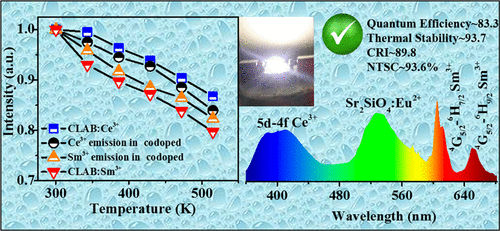当前位置:
X-MOL 学术
›
ACS Appl. Electron. Mater.
›
论文详情
Our official English website, www.x-mol.net, welcomes your
feedback! (Note: you will need to create a separate account there.)
Bright Red-Emitting Ca3LuAl3B4O15:Ce3+,Sm3+ Phosphors with High Thermal Stability for Elevating the Color Rendering of Near-Ultraviolet-Based White-Light-Emitting Diodes
ACS Applied Electronic Materials ( IF 4.3 ) Pub Date : 2021-09-08 , DOI: 10.1021/acsaelm.1c00663 Wasim Ullah Khan 1 , Waheed Ullah Khan 2 , Hao Lin 1 , Zhiyuan Cheng 1 , Muhammad Wajid Shah 3 , Yueli Zhang 1
ACS Applied Electronic Materials ( IF 4.3 ) Pub Date : 2021-09-08 , DOI: 10.1021/acsaelm.1c00663 Wasim Ullah Khan 1 , Waheed Ullah Khan 2 , Hao Lin 1 , Zhiyuan Cheng 1 , Muhammad Wajid Shah 3 , Yueli Zhang 1
Affiliation

|
The important objectives that have been usually ignored regarding the development of white-light-emitting diodes (WLEDs) are the stability, red spectral region deficiency, high correlated color temperature (CCT), and low color-rending index (CRI) that restrict their effectiveness for practical implementation. Herein, we used systematic screening of multi-doped Ca3LuAl3B4O15 (CLAB) samples to evaluate singly and doubly doped down-converting phosphors that exhibit tuning emission and spectrally pure red emission with high color purity at the ultraviolet light excitation and enhanced thermal stability. A comprehensive kinetic model of the energy transfer (ET) mechanism was developed and validated with the extensive experimental data set. Applying this model, we elucidated the ET mechanisms producing a spectrally pure red emission via dipole–dipole interaction. Moreover, CL0.8AB:0.1Ce3+,0.1Sm3+ revealed excellent chemical stability under 80% relative humidity and 80 °C severe thermal conditions. Interestingly, when the temperature was increased from 300 to 425 K, the intensity of Ce3+ emission was reduced with the production of certain Sm3+ emissions via ET. The WLED containing CL0.8AB:0.1Ce3+,0.1Sm3+ and Sr2SiO4:Eu2+ demonstrated warm white light with a high CRI of 89.8–85.7 and a low CCT equal to 4393–4482 K. These parameters are comparable to that of the commercially available YAG:Ce3+ phosphor combined with a blue LED chip (CCT ≈ 7746 K and CRI ≈ 75).
中文翻译:

具有高热稳定性的明亮红色发光 Ca3LuAl3B4O15:Ce3+,Sm3+ 磷光体,用于提高近紫外基白光发光二极管的显色性
关于白光发光二极管 (WLED) 的发展,通常被忽视的重要目标是稳定性、红色光谱区不足、高相关色温 (CCT) 和低显色指数 (CRI),这些都限制了它们的发展。实际执行的有效性。在这里,我们使用了多掺杂 Ca 3 LuAl 3 B 4 O 15 的系统筛选(CLAB) 样品用于评估单掺杂和双掺杂下转换磷光体,这些磷光体在紫外光激发下表现出调谐发射和光谱纯红色发射,具有高色纯度和增强的热稳定性。开发了能量转移 (ET) 机制的综合动力学模型,并使用广泛的实验数据集进行了验证。应用该模型,我们阐明了通过偶极-偶极相互作用产生光谱纯红色发射的 ET 机制。此外,CL 0.8 AB:0.1Ce 3+ ,0.1Sm 3+在80% 的相对湿度和80°C 的严酷热条件下表现出优异的化学稳定性。有趣的是,当温度从 300 K 增加到 425 K 时,Ce 3+通过 ET产生某些 Sm 3+排放,从而减少了排放。包含 CL 0.8 AB:0.1Ce 3+ ,0.1Sm 3+和 Sr 2 SiO 4 :Eu 2+的 WLED表现出暖白光,具有 89.8–85.7 的高显色指数和等于 4393–4482 K 的低 CCT。这些参数与市售的 YAG:Ce 3+荧光粉与蓝色 LED 芯片相结合(CCT ≈ 7746 K 和 CRI ≈ 75)。
更新日期:2021-09-28
中文翻译:

具有高热稳定性的明亮红色发光 Ca3LuAl3B4O15:Ce3+,Sm3+ 磷光体,用于提高近紫外基白光发光二极管的显色性
关于白光发光二极管 (WLED) 的发展,通常被忽视的重要目标是稳定性、红色光谱区不足、高相关色温 (CCT) 和低显色指数 (CRI),这些都限制了它们的发展。实际执行的有效性。在这里,我们使用了多掺杂 Ca 3 LuAl 3 B 4 O 15 的系统筛选(CLAB) 样品用于评估单掺杂和双掺杂下转换磷光体,这些磷光体在紫外光激发下表现出调谐发射和光谱纯红色发射,具有高色纯度和增强的热稳定性。开发了能量转移 (ET) 机制的综合动力学模型,并使用广泛的实验数据集进行了验证。应用该模型,我们阐明了通过偶极-偶极相互作用产生光谱纯红色发射的 ET 机制。此外,CL 0.8 AB:0.1Ce 3+ ,0.1Sm 3+在80% 的相对湿度和80°C 的严酷热条件下表现出优异的化学稳定性。有趣的是,当温度从 300 K 增加到 425 K 时,Ce 3+通过 ET产生某些 Sm 3+排放,从而减少了排放。包含 CL 0.8 AB:0.1Ce 3+ ,0.1Sm 3+和 Sr 2 SiO 4 :Eu 2+的 WLED表现出暖白光,具有 89.8–85.7 的高显色指数和等于 4393–4482 K 的低 CCT。这些参数与市售的 YAG:Ce 3+荧光粉与蓝色 LED 芯片相结合(CCT ≈ 7746 K 和 CRI ≈ 75)。











































 京公网安备 11010802027423号
京公网安备 11010802027423号